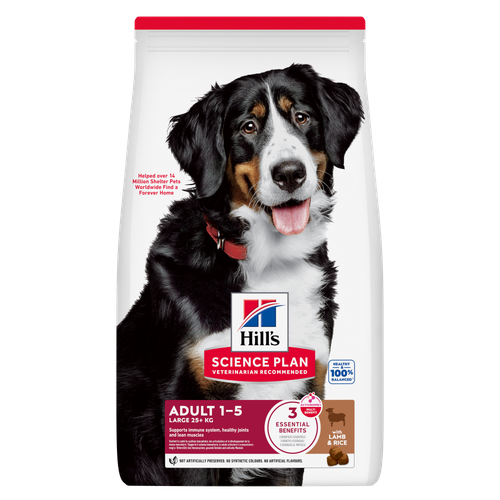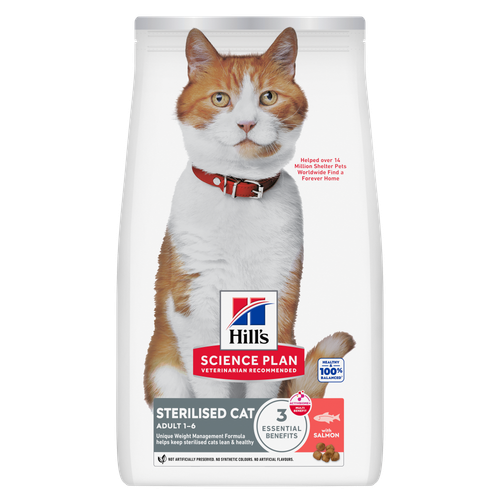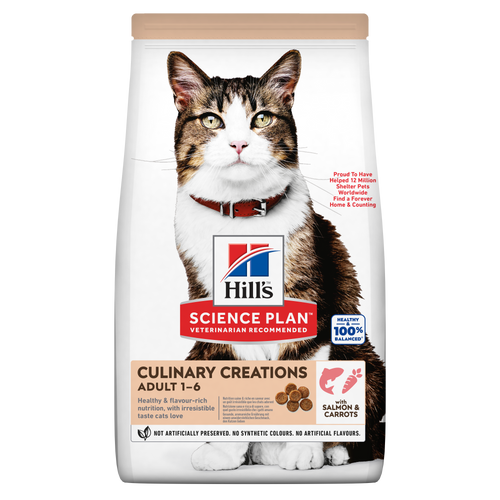
-
Find the right food for your petTake this quiz to see which food may be the best for your furry friend.Find the right food for your petTake this quiz to see which food may be the best for your furry friend.Featured products
 Adult Light Dog Food
Adult Light Dog FoodHill's Science Plan Light Adult Wet Dog Food is a complete premium pet food for adult dogs that tend to gain weight easily. This deliciously smooth loaf is formulated to deliver the appropriate amount of energy to support weight maintenance in adult dogs.
Shop Now Large Breed Adult Dog Food
Large Breed Adult Dog FoodHill's Science Plan Large Breed Adult Dog Food with Lamb & Rice is a complete pet food, specially formulated with ActivBiome+ Multi-Benefit Technology.
This food is specifically designed to fuel the energy needs of large breed dogs during the prime of their life.Shop Now Perfect Digestion Large Breed Puppy Food
Perfect Digestion Large Breed Puppy FoodPrecisely balanced nutrition with Hill's ActivBiome+ prebiotic blend actively contributes to supporting digestive health and overall wellbeing to help your pet feel their best
Shop NowFeatured products Sterilised Adult Cat Food
Sterilised Adult Cat FoodHill's Science Plan Adult Sterilised Cat Dry Food with Salmon is specially formulated with ActivBiome+ Multi-Benefit Technology. It is a precisely balanced nutrition, tailored to meet the needs of sterilised cats, to help keep sthem lean & healthy.
Shop Now CULINARY CREATIONS ADULT CAT FOOD
CULINARY CREATIONS ADULT CAT FOODHill's Science Plan CULINARY CREATIONS Adult cat food with Salmon & Carrots was formulated to provide a great-tasting experience to cats. Its delicious flavour and texture are combine with essential nutrients to support cats' optimal health during the prime time of their life. Specially formulated with high-quality salmon protein, essential taurine for heart health & balanced minerals to support kidneys & bladder.
Shop Now Adult Cat Food
Adult Cat FoodHill's Science Plan Adult Cat Food with Chicken is a complete pet food, specially formulated with ActivBiome+ Multi-Benefit Technology.
This food is specially formulated to fuel the energy needs of cats during the prime of their life.Shop Now -
Dog
- Dog Tips & Articles
-
Health Category
- Weight
- Food & Environmental Sensitivities
- Urinary
- Digestive
- Joint
- Kidney
-
Life Stage
- Puppy Nutrition
- Adult Nutrition
- Senior Nutrition
Cat- Cat Tips & Articles
-
Health Category
- Weight
- Skin & Food Sensitivities
- Urinary
- Digestive
- Kidney
-
Life Stage
- Kitten Nutrition
- Adult Nutrition
Featured articles Microchipping: The Facts | Hill's Pet
Microchipping: The Facts | Hill's PetThe government has announced that as of April 2016, all dogs in the UK must be microchipped by law.
Read More Pet Nutrition: What Makes "Healthy" Pet Food Healthy? | Hill's Pet
Pet Nutrition: What Makes "Healthy" Pet Food Healthy? | Hill's PetIn people, the right diet is very important. If you are eating the wrong way for your metabolism, activity level, age and lifestyle you could end up with health issues.
Read More The Incredible Science Behind Your Pet's Microbiome
The Incredible Science Behind Your Pet's MicrobiomeLearn what your pet's microbiome is, how it contributes to your pet's gut and overall health, and why nutrition is important in maintaining healthy microbiomes.
Read More -


Worried about your overweight cat? Some people think they look cute, but a fat feline may not be as happy (or healthy) as you think. One possible reason for weight problems is eating cat food that doesn’t give them satiety. The word ‘satiety’ means feeling full or satisfied, and it’s an important feeling to animals and humans alike. If your cat’s food isn’t satisfying their hunger, you may find your cat begging for snacks between meals. But with balanced nutrition that focuses on making your cat feel full, you can help control your cat’s weight and still have them feel satisfied between meals.
Why Weight Matters
Just like people, more and more cats are weighing in above their ideal weight, which can create health issues. According to International Cat Care, overweight cats are specifically more prone to long-term conditions like diabetes, bladder disease, and arthritis. So while that pudgy belly may look cute to some, it really is in your cat’s best interest to maintain a healthy weight.
It’s normal to feel concerned if your cat is carrying extra weight. The first thing you should do is consult a veterinarian to find out if there's an underlying cause to the weight gain. It is most likely that your cat is simply eating too much food and expending too few calories. If an exam shows no underlying cause, it may be time to consider changing their diet to focus on satiety.


Tasty Tips
Don’t Just Cut Back
When your cat feels full and satisfied after meals, they’re less likely to beg you for food outside of a typical feeding time. This makes your ability to control food intake that much easier, and your time together that much more enjoyable.
Some owners worry about changing their cat’s food in case they don’t like the new one, and are tempted to just reduce the amount they feed. This is far from ideal. Not only will your cat feel hungry, but you may end up underfeeding other important nutrients like protein or vitamins and minerals.
Foods formulated for safe, healthy weight loss take all of this into account. They may be higher in fibre to help your cat feel full, but will be balanced to make sure the proportions of all the essential nutrients are right. Some weight loss foods can even change your cat’s metabolism to favour fat burning rather than fat storing.
What to Serve
There is an overwhelming choice when it comes to pet foods. Sticking to reputable, well-established brands will help give you peace of mind, but it’s still important to make sure you have the right food specifically for weight loss.
Always involve your vet in a weight loss plan for your cat. They can help you choose the right food, advise you on feeding amounts, and track your cat’s progress to make sure they’re losing weight at a safe and healthy rate.
Supermarkets, and even pet stores, may not have the specific weight loss foods you need. Once the weight is off, you may be able to switch back to a supermarket brand, but always check in with your vet before making any changes.
Making Time for Exercise

Of course, it's not just food choice that can be an issue when it comes to your cat's weight. Just like their favourite two-legged friends, cats need exercise. Today's typical house cat simply doesn't spend enough time on the prowl to burn the calories they consume. Along with feeding your cat the right food that keeps them feeling satisfied, be sure to spend some time playing together every day.
Your cat will look to you to help them maintain their weight, so you need to be consistent in putting a plan together and sticking to it. By serving them the right food and finding time each day to get them moving, your overweight cat can soon be the picture of health and vitality. Your feline will look and feel better, and will have you to thank.


Kara Murphy is a freelance writer and pet parent who lives in Erie, Pa. She has a goldendoodle named Maddie.
Related products

Hill's Science Plan Adult Cat Food with Chicken is a complete pet food, specially formulated with ActivBiome+ Multi-Benefit Technology.
This food is specially formulated to fuel the energy needs of cats during the prime of their life.

Hill's Science Plan Adult Sterilised Cat Dry Food with Salmon is specially formulated with ActivBiome+ Multi-Benefit Technology. It is a precisely balanced nutrition, tailored to meet the needs of sterilised cats, to help keep sthem lean & healthy.

Hill's Science Plan CULINARY CREATIONS Adult cat food with Salmon & Carrots was formulated to provide a great-tasting experience to cats. Its delicious flavour and texture are combine with essential nutrients to support cats' optimal health during the prime time of their life. Specially formulated with high-quality salmon protein, essential taurine for heart health & balanced minerals to support kidneys & bladder.

Hill's Science Plan Senior Vitality Cat Food with Chicken & Rice provides precisely balanced nutrition that helps promote their everyday ability to get up and go.
Related articles

Cats with sensitive skin have special needs and even healthy cats can sometimes develop poor skin health. Learn more about sensitive skin symptoms in your cat, what you can do to help your pet feel more comfortable and get recommendations on sensitive skin cat food.

Learn about the causes of cat dermatitis, how to spot the symptoms and the best treatment options. Visit Hill's Pet for detailed guidance and tips.

Learn how your cat's poo can be a good indicator of her overall health, including how to spot unhealthy or abnormal cat poop and what it might mean.

Understand common skin issues in cats and how to manage them effectively. Learn signs and prevention, and get care tips. Find out more at Hill's Pet.

Put your cat on a diet without them knowing
Our low calorie formula helps you control your cat's weight. It's packed with high-quality protein for building lean muscles, and made with purposeful ingredients for a flavourful, nutritious meal. Clinically proven antioxidants, Vitamin C+E, help promote a healthy immune system.
Put your cat on a diet without them knowing
Our low calorie formula helps you control your cat's weight. It's packed with high-quality protein for building lean muscles, and made with purposeful ingredients for a flavourful, nutritious meal. Clinically proven antioxidants, Vitamin C+E, help promote a healthy immune system.

